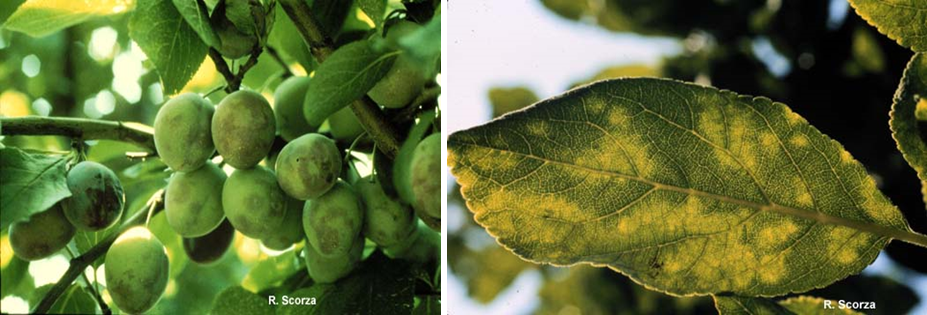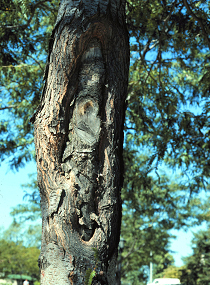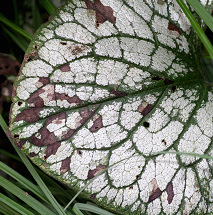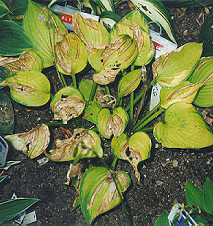What is purple-bordered leaf spot?
Purple-bordered leaf spot (also called eye spot or Phyllosticta leaf spot) is a common, but primarily cosmetic disease that affects maples (in particular Amur, Japanese, red, silver and sugar maple). Phyllosticta leaf spot is similar in many ways to other foliar diseases of maple such as anthracnose (see UW Plant Disease Facts D0002, Anthracnose) and tar spot (see UW Plant Disease Facts D0110, Tar Spot of Trees and Shrubs).
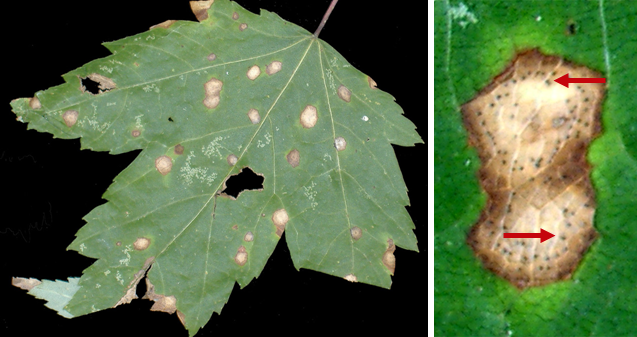
What does purple-bordered leaf spot look like?
Leaves with purple-bordered leaf spot have roughly circular dead areas (typically less than ¼ inch in diameter). Spots have tan to brown centers and distinct purple, red, or brown margins. Tiny, black, pimple-like reproductive structures (called pycnidia) often form within the spots, and are diagnostic. As spots mature, the centers may fall out, leaving roughly circular holes.
Where does purple-bordered leaf spot come from?
Purple-bordered leaf spot is caused by the fungus Phyllosticta minima, which overwinters in leaf litter. In the spring, rain and wind move spores of the fungus from the leaf litter to newly developing maple leaves, where infections occur. Spores produced on infected leaves can lead to additional infections within the tree canopy throughout the growing season.
How do I save a tree with purple-bordered leaf spot?
DO NOT PANIC. Although purple-bordered leaf spot may look unsightly, the disease is usually only a cosmetic problem, rarely causing significant damage to mature and vigorously-growing trees. Occasionally, purple-bordered leaf spot may defoliate trees early in the growing season, but these trees are typically able to produce new leaves within a few weeks. Defoliated trees should be watered and properly fertilized. Established trees require approximately one inch of water per week; newly transplanted trees (i.e., trees planted within approximately the past three years) require approximately two inches of water per week. If there is insufficient rain, apply water at the drip lines of trees (i.e., the edges of where the branches extend) using a drip or soaker hose. Only fertilize trees based on a soil nutrient test.
How do I avoid problems with purple-bordered leaf spot in the future?
If available, select maple varieties that are resistant to purple-bordered leaf spot. Compost, bury or burn (where allowed by local ordinance) leaf litter from infected trees in the fall or in the spring before trees releaf. Newly planted maples and established maples that have been severely affected by purple-bordered leaf spot for several years may benefit from treatments with a fungicide containing chlorothalonil, copper, mancozeb, neem oil, sulfur or thiophanate-methyl. Three treatments may be needed for adequate control: one at bud break, one when leaves are half expanded, and one when leaves are fully expanded. DO NOT use the same active ingredient for all treatments (particularly if you are using thiophanate-methyl). Instead, alternate the use of at least two active ingredients. This strategy will help minimize problems with fungicide-resistant strains of Phyllosticta minima. Be sure to read and follow all label instructions of the fungicide(s) that you select to ensure that you use the product(s) in the safest and most effective manner possible.
For more information on purple-bordered leaf spot:
Contact the University of Wisconsin Plant Disease Diagnostics Clinic (PDDC) at (608) 262-2863 or pddc@wisc.edu.
*Completed as partial fulfillment of the requirements for the graduate course: Plant Pathology 559: Diseases of Economic Crops.
© 2005-2024 the Board of Regents of the University of Wisconsin System doing business as University of Wisconsin-Madison Division of Extension.
An EEO/Affirmative Action employer, University of Wisconsin-Madison Division of Extension provides equal opportunities in employment and programming, including Title IX and ADA requirements. This document can be provided in an alternative format by calling Brian Hudelson at (608) 262-2863 (711 for Wisconsin Relay).
References to pesticide products in this publication are for your convenience and are not an endorsement or criticism of one product over similar products. You are responsible for using pesticides according to the manufacturer’s current label directions. Follow directions exactly to protect the environment and people from pesticide exposure. Failure to do so violates the law.
Thanks to Diana Alfuth, Donna Henderson, and Thad Kohlenberg for reviewing this document.
A complete inventory of UW Plant Disease Facts is available at the University of Wisconsin-Madison Plant Disease Diagnostics Clinic website: https://pddc.qa.webhosting.cals.wisc.edu.
Submit additional lawn, landscape, and gardening questions at https://hort.extension.wisc.edu/ask-a-gardening-question/.

